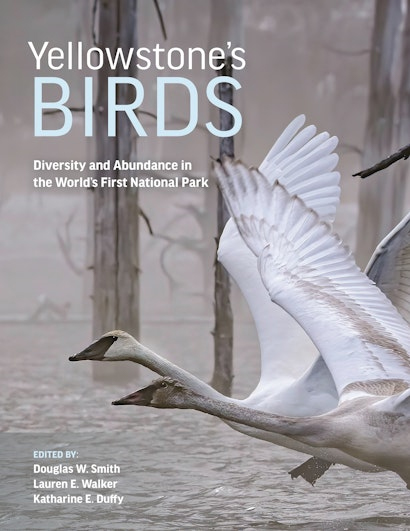Diversity And Abundance in The World’s First National Park
Review written by Chris Lotz on 17 March 2024

2023 Princeton University Press
I usually give an excellent book a 5-star review, but this one is so awesome that I think it deserves a 6-star review. It’s subjective, of course, but for someone who loves Yellowstone National Park, this is indeed a great coffee table book to have laid hands on. I’ve been unable to find anything I dislike about it, and it’s a good combination of scientific information and dramatic photos. Over 30 leading experts including the three main authors, have joined forces to provide the content for this book. The result is a detailed scientific account of the birdlife of Yellowstone National Park in delightfully accessible language. Additionally, the book is a work of art, with truly magnificent photography, a well thought-out and appealing layout and poetic introductions to chapters. A number of informative maps are also nicely presented.
This book is the first comprehensive account of the population trends (gleaned from decades of park data, breeding bird surveys, Christmas bird counts and other sources) and natural history of its birds. The stated goal of the book is to summarize what is known about Yellowstone National Park’s birds to plot the next move in the conservation context.
Near the start of the book are chapters on birding different parts of the park. Following this is a chapter entitled “The year I lost my birding mind” describing a year of bird monitoring by Kira A. Cassidy who lives near Yellowstone’s north entrance. This intriguing-sounding chapter is packed with lots of interesting observations, such as Common Raven being the most frequently observed bird, seen on 78 % of the days of 2019 – 3,900 of these birds over 286 days, sometimes in groups of more than 80 at a bison carcass. Like the rest of the book, interesting anecdotes are combined with extensive data presented in an understandable way.
Further chapters provide great information about charismatic birds of the park, starting with grouse, then raptors and owls, then waterbirds, then passerines. The raptor chapters include an account of one of the park’s really special birds, Golden Eagle, and a chapter on Red-tailed Hawk called “A common raptor in an uncommon place”. The owl chapter is called “Listening for owls in Yellowstone” and gives great information about the good number of species occurring in the park including sought-after ones like Great Grey and Boreal Owls. This chapter, like others, emphasizes ethical birding, e.g. there is a box about watching owls from a distance so as not to disturb them. Conservation is a recurring theme in the book, as is the value of citizen science.
The waterbirds section starts with a long and hugely informative chapter on “Yellowstone’s iconic bird”, the Trumpeter Swan. This summarizes over 90 years of data, highlighting the dramatic decline between 1971 and 1986. The elusive reasons as to why this decline occurred, are then discussed, including text about the 2011 park workshop aimed at helping to save Yellowstone’s swans.
Further waterbird chapters (on loons or divers, beautiful Harlequin Ducks, the waterfowl of Yellowstone, “The colonial waterbirds of the Molly Islands”, and shorebirds), are equally enlightening, providing an absolute wealth of information on the natural history, conservation and ecology of these birds. The book ends with detailed chapters about the ravens of Yellowstone, charismatic Clark’s Nutcrackers (including threats to Whitebark Pine and the famous mutualism between this tree and the nutcrackers), and songbirds.
I wish I had access to this remarkable book when I was living in Wyoming. But at least now I can read through the delightfully written, easy-reading chapters of this book and learn an immense amount. I would recommend buying this beautiful coffee table book if you want an “armchair visit” to Yellowstone, the world’s oldest national park, even if you don’t foresee the privilege of actually visiting. Better, of course, is if you read the book before, during and after (to re-live it all) visiting the park.
